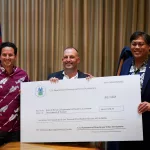Governor Josh Green, M.D., alongside U.S. Senator Brian Schatz and HUD Regional Administrator Jason Pu announced that Hawai‘i has been awarded more than $6.6 million in new federal grant funding to help build more housing.
The new Pathways to Removing Obstacles to Housing (PRO Housing) program rewards state and local governments that reform land-use policies and other local barriers that constrain the supply of affordable housing.
In Hawai‘i, lack of infrastructure has been cited as an important obstacle to building more housing. With this PRO Housing grant, The Hawaiʻi Office of Planning and Sustainable Development will create a State Infrastructure Bank as a long-term infrastructure financing solution and accelerate critical infrastructure investments to unlock housing production at a larger, more impactful scale than existing initiatives. Additionally, the grant will allow the state to increase capacity to identify and address regulatory burdens that are driving up the cost of housing across the state.
For decades, local zoning and land use regulations, as well as the lack of necessary housing-related infrastructure, have prevented housing production from keeping pace with population and economic growth, resulting in a nationwide housing shortage. The PRO Housing program will help reverse this trend by rewarding state, local, and regional jurisdictions that address exclusionary zoning practices, land use policies, and housing infrastructure to increase the supply of affordable housing. These policies include increasing density, reducing minimum lot sizes, creating transit-oriented development zones, streamlining or shortening permitting processes and timelines, expanding by-right multifamily zoned areas, allowing accessory dwelling units on lots with single-family homes, eliminating or relaxing residential property height limitations, eliminating or reducing off-street parking requirements and allowing the conversion of vacant retail and office space into residential housing. In this first round, applications were submitted from more than 175 communities – representing a wide variety of demographics, geographies, and population sizes – across 47 states and territories.
Photo credit: Office of Governor Green
